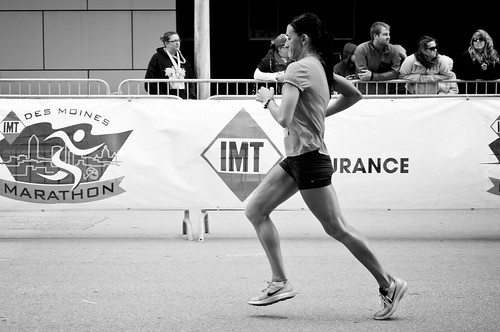Mind over Marathon: Overcoming Self Imposed Limits

![]() photo credit: IABoomerFlickr
photo credit: IABoomerFlickr
From a very early age I was taught the power of visualization and have used it in many areas of my life, including running. So it was no surprise to me that many elite athletes use this tool to help them achieve their training and racing goals. If you haven’t heard of visualization before, it may be something you want to consider adding to your program.
Visualization and the Conscious Mind
Visualization is the process of using all of your senses to recreate or create a specific experience in you mind. Your mind is made up of two parts; the conscious mind and the subconscious mind. The conscious mind is the part of your mind that is responsible for logic and reasoning. If I was to ask you what one plus one was, your conscious mind would perform the calculation. Your conscious mind also controls all of your intentional actions like making the decision to sprint at the end of a race. Whenever you are aware of what you are doing, you are using your conscious mind
The Subconscious Mind
The subconscious mind is the part of your mind responsible for involuntary actions like breathing, how quickly your heart beats and your emotional state, things that all change depending on your running pace. Your subconscious mind is also the place where your beliefs and memories reside. What you believe in your subconscious always gets pushed into your conscious mind where it becomes evident in your results.
A clear example of the subconscious mind affecting the conscious mind can be seen in the quest to break the 4:00 mile. In 1943 the world record for the mile was 4 minutes and 2 seconds. At that time it was thought to be impossible to run a 4 minute mile. Doctors and coaches thought that if someone ran a 4-Minute mile, they would die of a heart attack shortly afterwards.
The Proof
For 11 years, the record remained at 4:02. And then on May, 6 1954 Roger Bannister set a new record for the mile by running it in 4:00. Six weeks later John Landy broke the 4:00 barrier with a 3:58. It wasn’t that there was some major technological advance in running that year that led to those breakthroughs. The belief that it was impossible to run a 4:00 mile had changed.
-
Note: Since then the four minute mile has been broken hundreds of times and new barriers were set. John Walker, from New Zealand was the first to run the mile under 3:50 and subsequently ran 135 more sub-four-minute miles during his career. Steve Scott, an American has run the most sub-four-minute mile ever, with 136.
-
Currently, the mile record is held by Morocco‘s Hicham El Guerrouj, who ran a time of 3:43.13 in Rome in 1999.
Through visualization, you can influence the beliefs you hold in your subconscious mind so that your conscious mind can bring about a new reality.
The Technique
1. Plan it
Visualization can be performed anytime in any place. You can do it while sitting in a quiet space at home or while out on the run. The length of time you visualize and how often can also vary. Do what feels right for you; however, the closer you get to your race, the more often you may want to practice.
2. Create it
Create images as clearly as you can. Take a mental snapshot how you would look and feel at various points in your race. Experience the doubt on the starting line, the excitement of the first mile, pushing through fatigue at the 23rd mile and most of all the elation of achieving your goal.
Avoid glossing over and just imagining a happy outcome, take a good hard look at ALL of the realistic challenges you may face along the way (dehydration, hunger, stomach pain, chafing, blisters) and how you will overcome them.
3. Replace it
Replace negative thoughts with positive ones. Instead of using “I can’t” and “I don’t”, use “I can” and “I will”. Don’t compare yourself to others during this time. Focus on your goal and only things that will help you with achieving it. Appreciate your training; health, family, friends, etc.
There is no right or wrong way to perform visualization. It is a skill that with practice, you will become better at. So the next time you are training hard and plateau at a performance level that is below where you want to be, consider that the problem isn’t physical.
BIO
Lisa H. is the writer behind Ten Bulls Running; A blog for runners who want to grab the bull by the horns and improve their performances in a holistic and natural way.





